Making a doodle collage is like making a creative mess—on purpose! Start by grabbing sturdy paper, favorite magazines, scissors, and glue. Pick a fun theme, maybe pets or outer space. Doodle shapes, patterns, and silly lines with markers or pens. Snip magazine pictures, then play with where everything goes before you glue. Layer doodles over clippings, splash on color, and add quirky details. Show it off or share online! Want cool tricks and juicy tips to take it even further?
Key Takeaways
- Gather materials such as magazines, paper, glue, scissors, and choose a fun theme for your collage.
- Plan your layout with simple doodle shapes and sketch lightly for flexibility before gluing pieces down.
- Cut out magazine images that match your theme and arrange them with doodles for a cohesive look.
- Stick to a limited color palette and layer colors and textures to add visual interest and depth.
- Display your finished collage creatively and share it online to connect with other collage artists.
Gathering Your Doodle Collage Supplies
Before anyone dives into making a doodle collage, there’s a little adventure called “gathering supplies”—and honestly, it’s half the fun.
The first step in collage art is picking a sturdy base. Some people go for stretched canvas, others grab a trusty piece of cardboard, but whatever it is, it needs to hold a lot of creativity.
The creative process gets more exciting as you pile up magazines, postcards, catalog pages, or fun wrapping paper, each promising some wild new texture or color.
Keep in mind, glue sticks work well for lighter stuff, but for chunky pieces or the sparkly finale, most people switch to tacky glue or Mod Podge.
Add in scissors, plus bonus items like glitter or buttons, and you’re all set!
Choosing a Theme for Your Collage
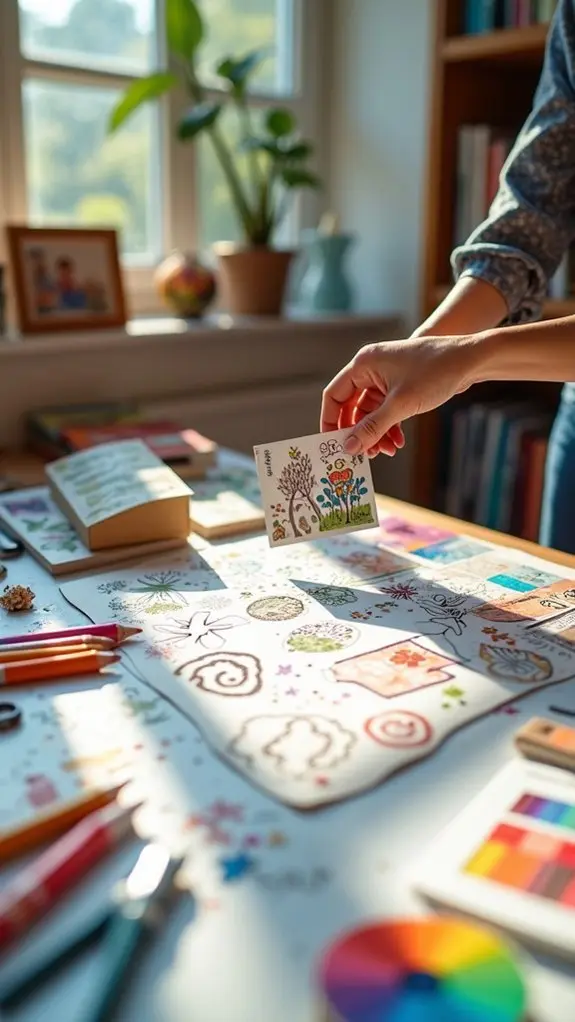
How does someone even start making order out of all the wild scraps and zany doodle ideas in their head? Choosing a theme is like turning on the light in a dark, doodle-filled closet. It instantly helps organize creative chaos and sets the stage to create something beautiful.
Think about topics that make you excited—maybe you love cats, outer space, or bright neon colors. Even your favorite hobbies can give your collage a personal twist. Sticking with a strong theme adds that cool “wow” factor, making each part feel connected.
- Favorite seasons (like spooky fall or sunny summer)
- Personal interests (books, music, pets)
- Artistic styles (whimsical, abstract, comic-inspired)
Whether simple or wild, the theme is your secret weapon for collage greatness!
Basic Doodling Techniques to Try
Jump right in and let the pen take the lead—doodling is all about letting your creativity run wild, but even the wildest ideas have a few tricks to help them look cool.
Start with simple shapes like circles, squares, and triangles; they’re like the building blocks for future doodle masterpieces. Suddenly, a humble circle could transform into a quirky cartoon face or a funky sun!
Mix things up with patterns—stripes, polka dots, or even wild zigzags—for some serious texture action. Try using different line thicknesses to make things pop and draw the viewer’s eye.
When it’s time for color, keep it fresh with a small color palette. Five or six colors are plenty to add punch without making everything look chaotic.
Have fun!
Selecting and Cutting Magazine Images
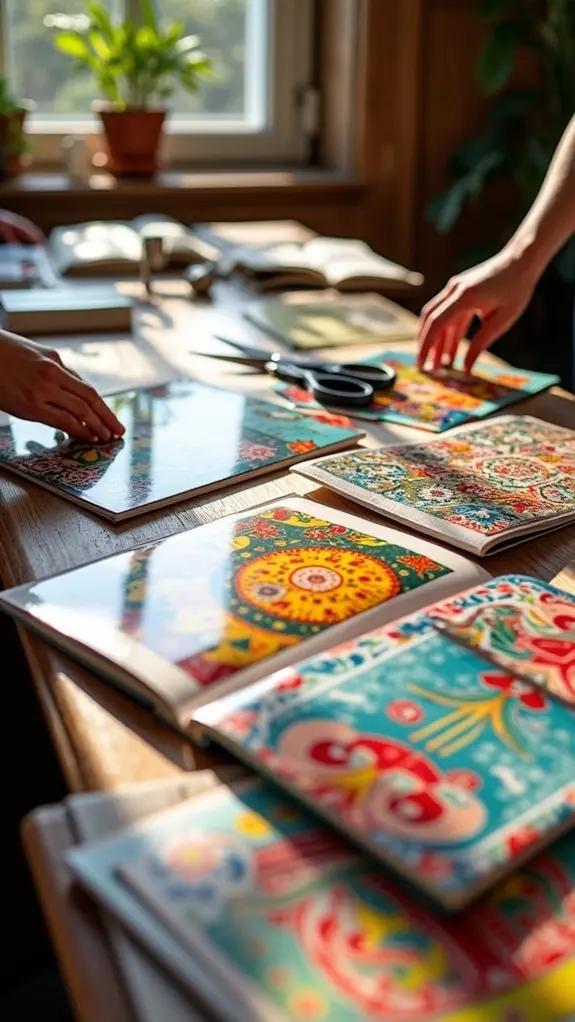
Now comes the fun part—finding magazine images that really jump out and fit your collage’s mood, almost like hunting for buried treasure in those glossy pages!
It helps to snip carefully with sharp scissors or a craft knife because clean edges make all your hard work look seriously impressive.
Once you’ve gathered your colorful stash, try spreading the pieces out and mixing them around—there’s no law against rearranging a few dozen times until you get that “aha!” moment.
Choosing Inspiring Visual Elements
- Mix colors, textures, and patterns for depth.
- Choose images that fit your overall theme.
- Experiment with layout before gluing anything down.
Let your creativity lead the way!
Cutting Techniques for Precision
Snip away with confidence—choosing and cutting magazine images for your doodle collage is where the magic starts to happen. First, make sure to pick something that pops—hunt for bold colors, textures, and images that fit your theme. Don’t settle for “just okay”—choose images that add energy and excitement! Use sharp scissors or a craft knife for those tricky edges and tiny details, so your new art doesn’t look like it lost a wrestling match with a dull blade. Vary image and text sizes; it’ll give your collage depth (and make you look like a collage pro). Here’s a quick cheat sheet to help:
| Tool | Technique | Result |
|---|---|---|
| Precision scissors | Careful snipping | Smooth edge |
| Craft knife | Fine details | No paper tears |
| Overlapping layers | Experimentation | Added depth |
Organizing Image Collections
Once the cutting part is out of the way and your fingers are probably covered in tiny paper bits, it’s time for a serious treasure hunt: picking and organizing the coolest images for your doodle collage.
Start by spreading out all your cut-outs so you can see what you have to work with—think of it like assembling a superhero team, but with pictures. Use image categorization techniques to separate images by color, theme, or even mood.
Try mixing up shapes and sizes for a wild, balanced look. Need fresh ideas? Use inspiration sourcing tips from online mood boards or your favorite playlists.
Stay on top of your stash with easy collection management strategies—tiny folders, or even just labeled plastic bags, can save major stress later.
- Sort images by color, shape, or theme
- Get inspiration from songs, movies, or the web
- Use labeled folders or bags to keep your collection tidy
Planning Your Collage Layout
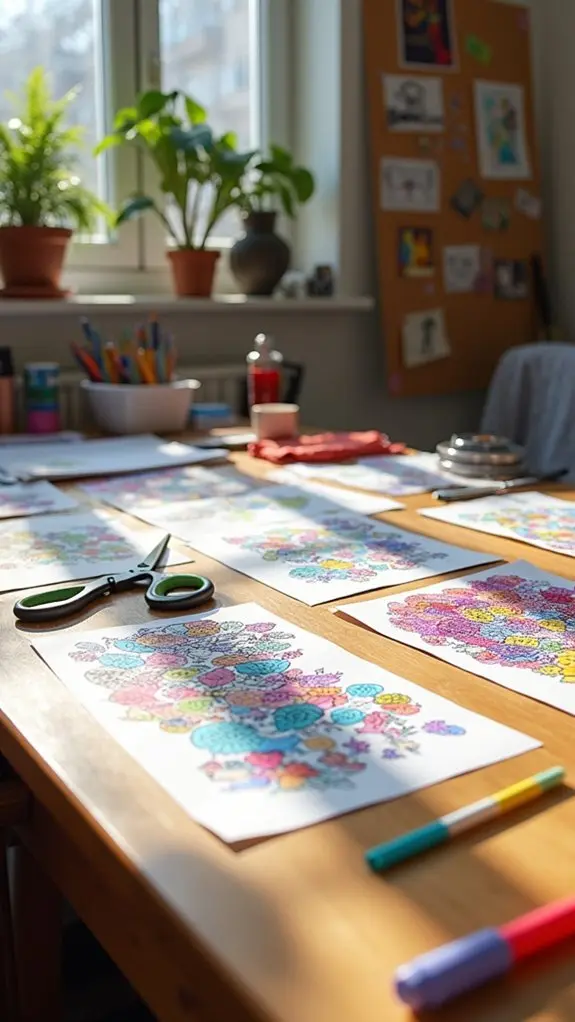
Before jumping in with pens blazing, planning the layout of a doodle collage can save a lot of headaches—and maybe even a few sighs of “oh no, what have I done?”
Starting with a clear theme or concept is like choosing a playlist before a party; it shapes everything that comes next. For collage composition tips, it’s smart to sketch a rough layout on scrap paper first, just to see how things fit.
Layout design principles suggest mixing up doodle sizes to keep things lively—they don’t all have to be giants or squished in like sardines. Use a light pencil to mark ideas on your main page, so changes are easy.
Doodle spacing strategies? Try numbering your doodles in order, or just go wild and scatter them randomly for playful energy!
Combining Doodles With Collaged Elements
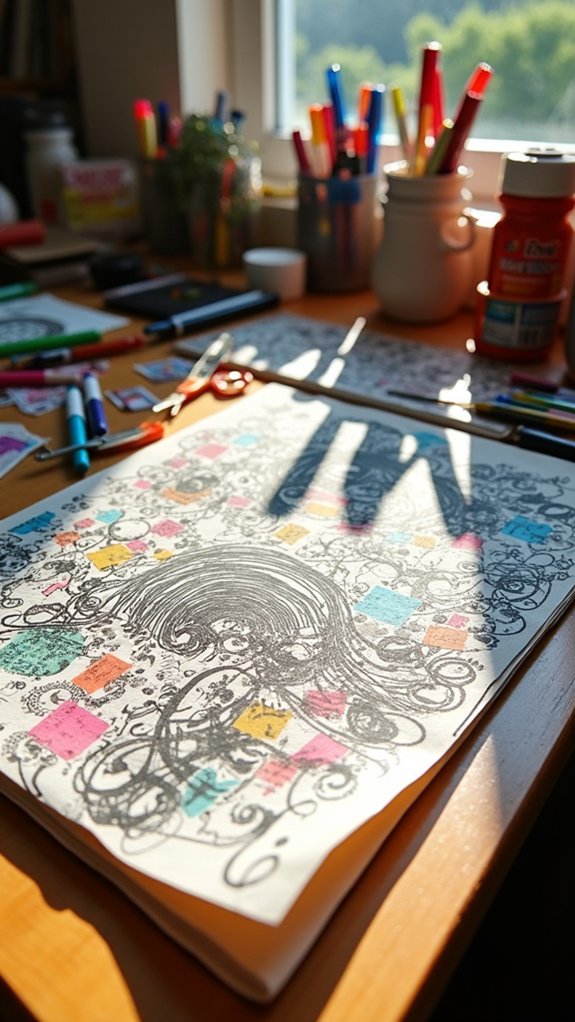
With the basic layout sketched and the doodle ideas percolating, it’s time for the real magic—blending those wild doodles with actual bits and pieces from everyday life.
Think magazine cutouts, scraps of wrapping paper, cool postcards—whatever you can find! By matching your favorite doodle styles with these collaged elements, you’ll kick your creative flow into high gear.
Sketch lightly around collage pieces, letting the doodles wiggle and wander in, so everything feels like one big awesome scene. Pick 5-6 colors and stick with them for both your doodles and collage techniques—that way, everything matches, like it was totally planned (even if it wasn’t).
Layer doodles over collaged areas for extra pop and don’t worry if it’s not perfect; messiness adds charm!
- Try out different doodle styles for each collage piece
- Keep your color palette limited for harmony
- Let overlapping shapes and lines create playful movement
Gluing and Layering for Best Results
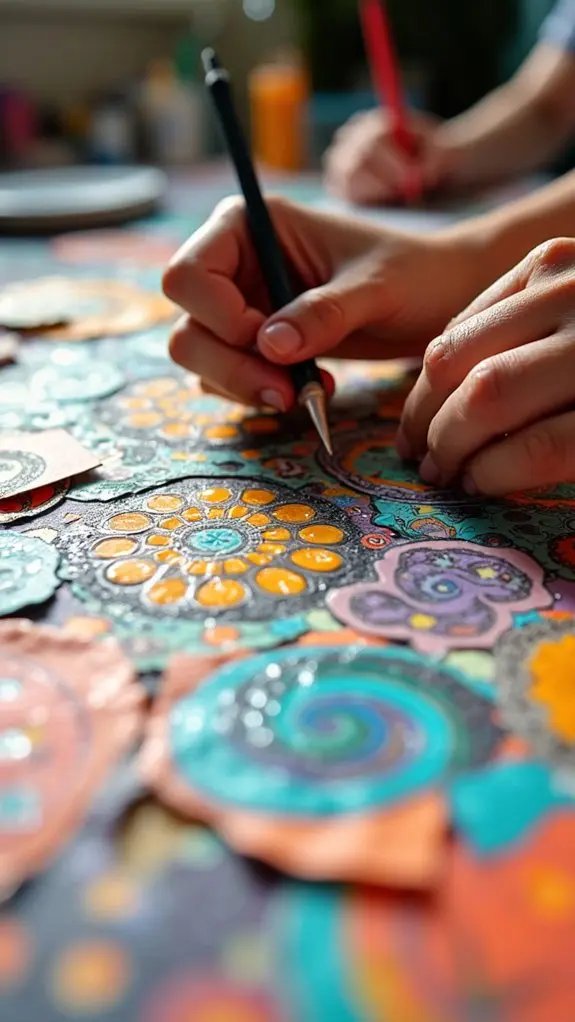
Jump in and grab that glue stick, because it’s time to bring the whole doodle collage together!
With smart collage composition techniques, start gluing the biggest doodled pieces at the back—think of it as building the coolest paper lasagna ever. For lightweight paper, use a glue stick so you don’t get weird wrinkles or air bubbles.
Got chunkier stuff? Try liquid glue or even a glue gun, but go easy—you want sticky, not soggy! Layer in the smaller elements on top, playing with your layout for some 3D magic.
Here’s one of the best adhesive application tips: let each layer dry before adding another to keep things in place.
For pro-level layering strategies, finish things off with Mod Podge for a smooth, shiny touch!
Adding Color and Extra Details

Color explosion, anyone? Now’s the time to bring your doodle collage to life with color and extra pizzazz! Using color theory as your trusty guide, pick 5–6 colors (plus trusty black and white) to keep things looking fresh rather than frantic.
Colored pens, like those vibrant Archer & Olive Calliographs, are perfect for adding bold pops and layering techniques help dole out some real depth. Try tossing in geometric shapes or playful patterns between doodles—they’re like visual speed bumps that keep things interesting.
Balance is the name of the game, so grab lighter or darker shades to highlight or shade, making certain elements shout, not mumble!
- Stick to a limited color palette for unity
- Layer colors for depth and richness
- Fill gaps with patterns or textured backgrounds
Displaying or Sharing Your Finished Doodle Collage
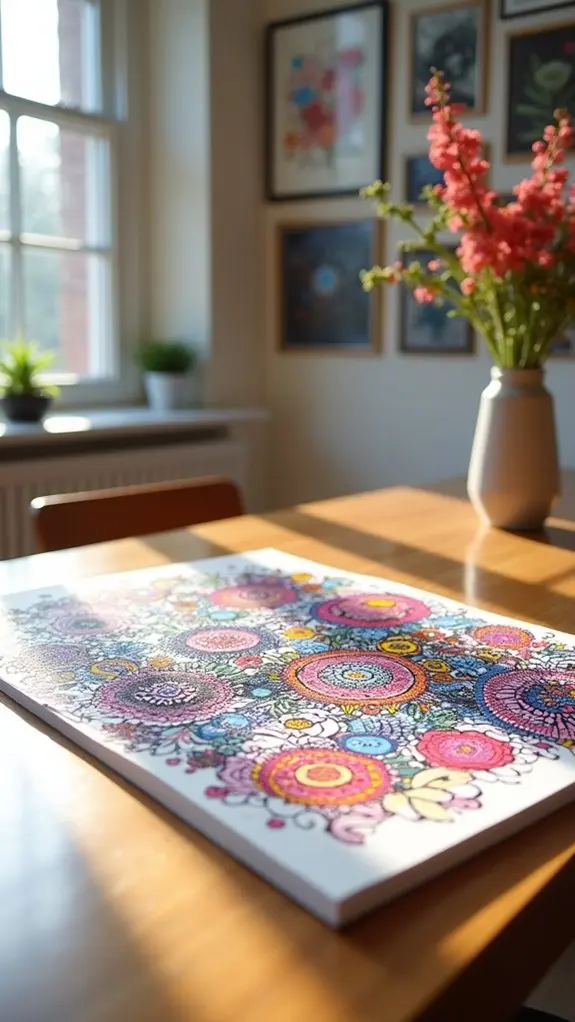
Honestly, after pouring all that creativity into a doodle collage, it deserves to be seen—no sense in letting it hide in some dusty sketchbook!
Think about some cool collage exhibition ideas: frame your masterpiece or hang it up with clips in your room so everyone can admire your art skills.
Want to get fancy? Snap a high-quality photo or scan it to save those popping colors and tiny details, then try some digital sharing tips by uploading it to a personal blog or portfolio.
Craving bigger crowds? Post your collage on Instagram or Pinterest—using awesome hashtags for social media engagement—so like-minded artists and friends can find your work.
Plus, sharing in online art communities can snag helpful feedback and boost your creative confidence!
Frequently Asked Questions
How to Make a Collage for Beginners?
When beginners want to make a collage, they should select diverse collage materials, explore simple collage techniques, and draw collage inspiration from magazines or nature. Arranging pieces for visual balance and adhering them carefully encourages creativity and experimentation.
How Do I Create My Own Doodle?
Creating a personal doodle involves exploring various doodle techniques, seeking creative inspiration from art books or online sources, and assembling basic art supplies. Light sketching, experimenting with shapes and patterns, and regular practice help develop individual artistic expression.
Which App Is Used for Doodle Art?
When exploring digital tools for doodle art, individuals often choose apps like Procreate, Adobe Fresco, and Canva. These platforms enable a variety of doodle techniques and serve as sources of artistic inspiration for creating expressive designs.
Is Doodle Art Easy?
Doodle art is generally considered easy due to its reliance on simple doodle techniques. Beginners can find doodle inspiration everywhere, use basic doodle materials, and freely explore creativity without advanced skills, supporting accessibility for all artistic experience levels.
Conclusion
Creating a doodle collage isn’t just an art project—it’s an adventure. Anyone can jump in, mixing wild doodles and cool magazine clippings for a masterpiece that’s totally one of a kind. There’s zero pressure to make it perfect, so mistakes actually make your collage better! With the right supplies, a splash of color, and a dash of imagination, anyone can turn a simple piece of paper into epic wall-worthy art. So, what’s stopping you? Start doodling!

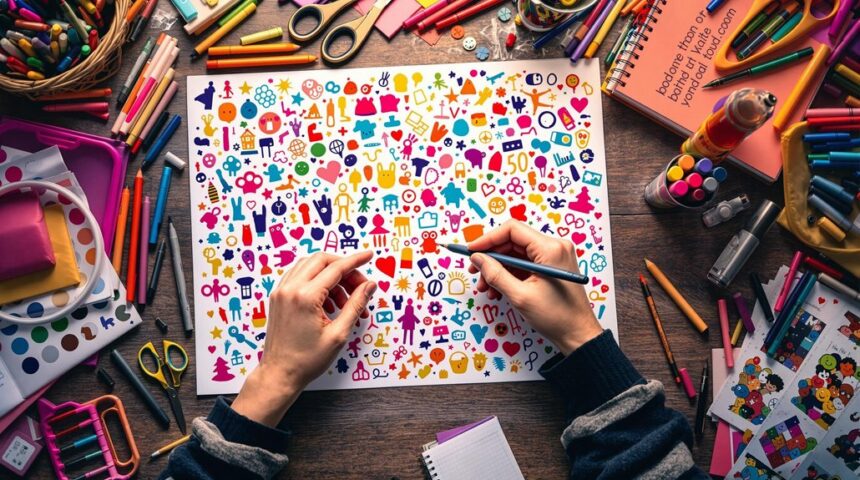
Leave a Reply